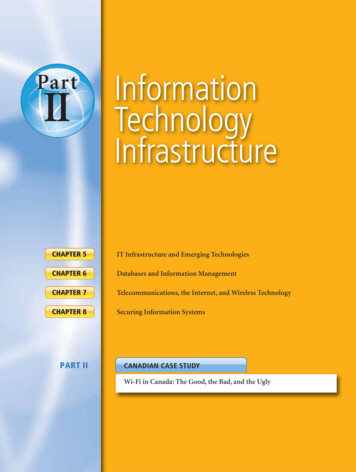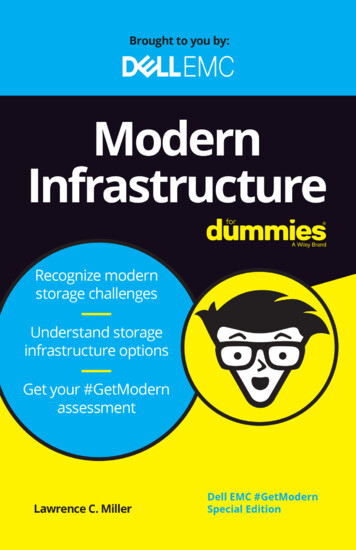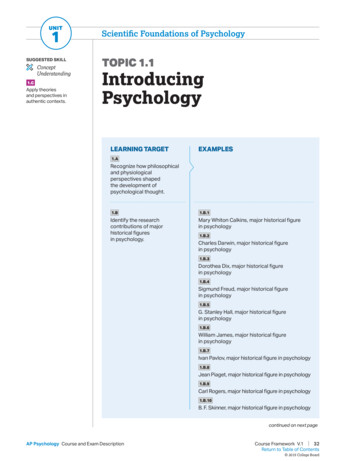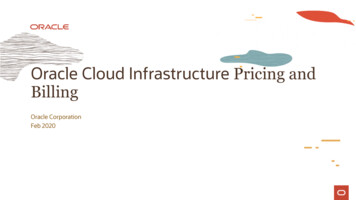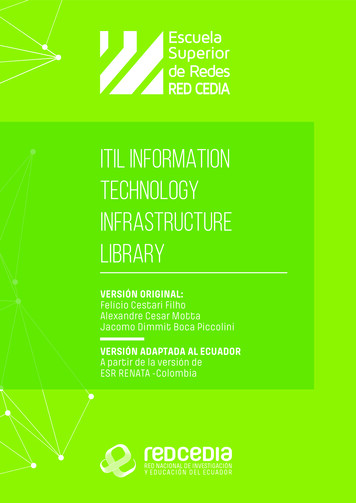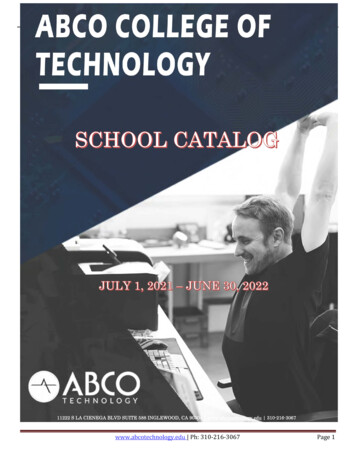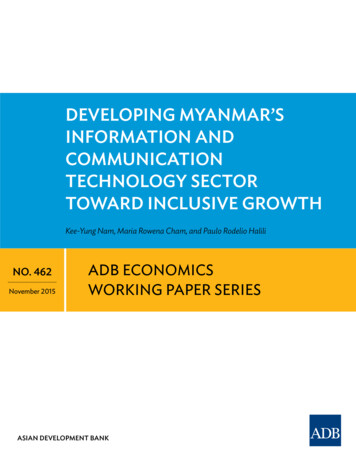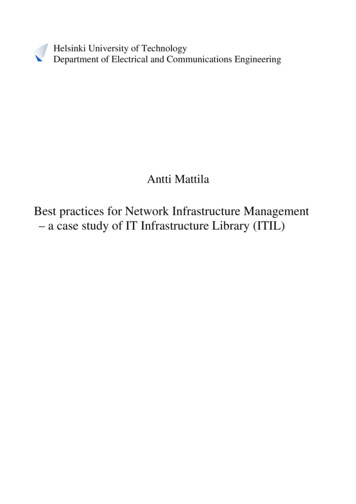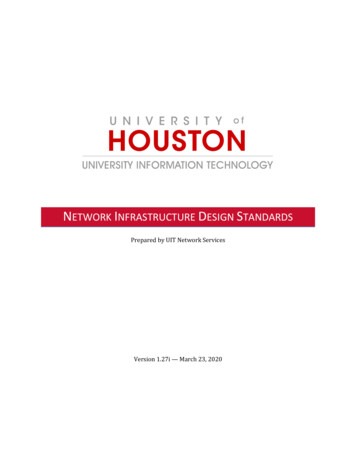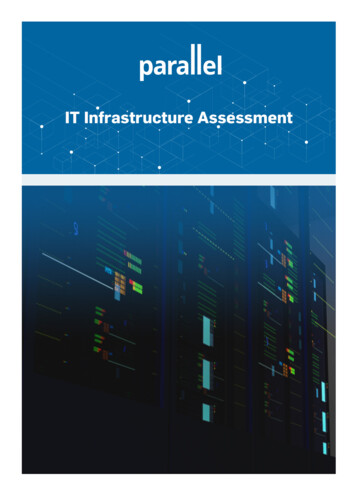
Transcription
INFORMATION TECHNOLOGY INFRASTRUCTURE: A HISTORICAL PERSPECTIVE OF FLEXIBILITYJournal of Information Technology ManagementISSN #1042-1319A Publication of the Association of ManagementINFORMATION TECHNOLOGY INFRASTRUCTURE: AHISTORICAL PERSPECTIVE OF FLEXIBILITYDOUGLAS E. TURNERUNIVERSITY OF WEST GEORGIAdturner@westga.eduWILLIAM M. LANKFORDUNIVERSITY OF WEST GEORGIAwlankfor@westga.eduABSTRACTIn today’s business environment successful information technology (IT) applications are expected to grow and adapt tonew market conditions. IT vendor tout their new products as having such characteristics as open source code and multipleplatform adaptability. But as with previous business processes and systems the successful IT application is in need of the basicattribute of flexibility. Utilizing three suggested dimensions of flexibility and the strategic flexibility framework this paperexamines the foundation and the concept of IT flexibility and the resemblances found when compared to the concept ofmanufacturing flexibility and competitive advantage.Keywords: information technology, manufacturing flexibility, organizational effectivenessINTRODUCTIONThe business landscape of today requires new andinnovated applications in the areas of marketing,manufacturing, and customer service to meet growingcustomers’ demands.As organizations strive forcompetitive advantages with their applications, the conceptsof “time to market” and “flexibility” has become significantattributes. This new business environment has producedconcepts such as campaign management systems (CMS) formarketing, supply chain management (SCM) formanufacturing, and customer relationship management(CRM) for customer service. CMS may be viewed as amarketing system that assists in the planning,product/service definition, scheduling, and execution of amarketing campaign. SCM is often viewed as the supportsystem to aid manufacturing in the efficient production anddelivery of goods. CRM can be defined as a technologicalmechanism used to enhance the customer’s relationship withan organization. While all of these relatively newmanagerial system tools are technologically based, theyseem to have a single inherent quality, that of flexibility.That flexibility is believed to be the basis of a competitiveadvantage.But the concept of flexibility that many of theseapplications are built upon is not new, and actually evolvedfrom old concepts. This paper investigates the foundationJournal of Information Technology Management, Volume XVI, Number 2, 200537
INFORMATION TECHNOLOGY INFRASTRUCTURE: A HISTORICAL PERSPECTIVE OF FLEXIBILITYand components of flexibility found in the historicalmanufacturing sector, and employ those components in thecontext of defining information technology environments forcompetitive advantages. Specifically, we will attempt toquantify and define information technology competitiveenvironments as they relate to information technologyinfrastructure flexibility (ITIF).To achieve this objective we must first define theconcepts of competitive advantage (CA) and sustainablecompetitive advantage (SCA). Secondly, we will discuss thedimensions of flexibility, followed by the review ofcomparative manufacturing flexibility. Next, the concept ofIT as a set of components is examined utilizing an exampleof electronic data interchange. The result of thesedeliberations is the identification of the dimensions of ITIF,and discussion about ITIF and competitive advantages.COMPETITIVE ADVANTAGEAccording to Porter [46], competitive initiativescentered around technical superiority, product or servicequality, and comprehensive customer service yield thehighest potential for a longer-lasting competitive edge.These longer-lasting competitive initiatives dramaticallyincrease the benefit period for the implementing firm, but tosecure an open ended benefit period, a firm must pursue asustained competitive advantage (Thompson and Strickland,[53]).Specifically, Rumelt [48] defined sustainedcompetitive advantage as existing only after the efforts ofrivals to duplicate the advantage have failed and ceased.Sustained competitive advantage is obtained by firmsimplementing strategies that exploit their internal strengths,through responding to environmental opportunities, whileneutralizing external threats and avoiding internalweaknesses (Barney, [3]).Competitive advantage can be defined as theimplementation of an action creating value that is not beingsimultaneously created by any current or potentialcompetitors (Barney, McWilliams, and Turk, [4]). A firmhas a competitive advantage whenever it has an edge overrivals in attracting customers and can defend against thecompetitive forces of: rivalry among sellers, substituteproducts or services, potential new entrants to the field, andpressures from suppliers and buyers (Porter, [46]). Thesearch for a competitive advantage requires the continualexamination of both internal and external positions of afirm’s opportunities such as emerging new technologies, andthreats such as changing buyer needs and demands(Thompson and Strickland, [53]).To achieve a measure of competitive advantage, theaction of the firm must acquire or possess some exploitableresource or capability that is rare among competing firms(Barney, [3]). An organization’s capabilities and resourcesare defined by all of the assets used to develop, manufacture,support, and deliver products and services to customers(Daft, [18]). These resources can be categorized into areasof human, organizational, or technical investments (Beker,[5]; Tomer, [54]; Williamson, [60]).Competitive advantage, according to Thompsonand Strickland [53], is nearly always achieved by successfuloffensive moves by a firm against its rivals. Types ofoffensive moves available include such tactics as: mountinga preemptive strike that involves being the first mover tocreate a position difficult for rivals to duplicate, exceeding acompetitor’s strengths by reducing the cost of deliveringgoods and services to customers, and capitalizing on theweaknesses of competitors by supplying a broader range ofofferings and support services (Kotler, [36]; MacMillian,[42]).SUSTAINABLE COMPETITIVEADVANTAGEEven if an organization achieves some measure ofcompetitive advantage, the benefits enjoyed are subject todecay as rivals successfully replicate the advantage in themarket, thus reducing that specific parameter to being justanother base line key success factor for that market(MacMillian, [42]). Thompson and Strickland [53] definebase line key success factors as strategic related approaches,actions, competitive capabilities, and business outcomes thatevery firm within a market must be competent at in order tobe minimally competitive and financially successful. Vitale[58] specifically addressed the IT base line key successfactors, in stating that “IT may provide limited advantages tothe innovator before being readily copied by competitors”.In the arena of IT applications, as with other goods or set ofservices that are universally available by a large number ofcompeting firms, the opportunity of that good or servicealone to be a source of competitive advantage for a singlefirm is very low (Wernefelt, [59]).Journal of Information Technology Management, Volume XVI, Number 2, 200538
INFORMATION TECHNOLOGY INFRASTRUCTURE: A HISTORICAL PERSPECTIVE OF FLEXIBILITYTHE DIMENSIONS OFFLEXIBILITYThe concept of flexibility can be traced back to thestudy of oscillations in the business cycle (Hart, [25];Kindleberger, [32]; Knight, [37]; Lange, [38]). Duncan [20]defines flexibility as the ability of a resource to be used formore than one end product, with ITIF measured as thedegree of sharability and reusability. Evans [21] suggestedthe issue of elasticity, allowing a firm to revert back to apreexisting norm after accommodating some temporarycondition. Other related terms such as robustness, slack,pliability, and agility suggest differing levels of meaning asto yielding to change pressure, capacity of adoption, andsusceptibility of modification (Bonder, [8]). Leeuw andVolberda [39] offered the perspective of flexibility as afunction of the degree of control capacity of management.The general terms associated with flexibility that have beenpreviously described as mobility, agility, responsiveness,and suppleness will also be included.The process of the reviewing the terms associatedwith flexibility in both the areas of manufacturing andinformation technology systems suggests that they may notbe a singular concept, but instead represent different factorsof flexibility based on the firm’s perspective. Thus wepropose that flexibility of a system may be best representedby three dimensions or influences. The three dimensions aredefined as: 1) slack, the degree of excess capacity, underutilization or salability, 2) adaptability, the degree ofversatility, openness, robustness, and 3) intensity, the degreeof repetitiveness and frequency of changes in a parameter.Individually each dimension may be insufficient torepresent the construct of flexibility, but collectively it issuggested that these three dimensions can adequatelyaddress both the manufacturing and technology flexibilityparameters of a system. In example given a system that hasa sufficient reserve of adaptability and intensity, but operatesat 100 % utilization (zero slack) would have very little roomto accommodate system changes.Borrowing from the discipline of electricalengineering the three dimensions of flexibility can begraphically represented by a modified sine wave as shown inFigure 1. The three dimensions of flexibility are defined asslack, adaptability, and intensity. Slack is identified as thegraphical component “S”, this represents the footprint or thewidth of the horizontal plane where the aptitude of theparameter can expand or contract as demanded. A narrowfootprint denotes a minimal amount of slack, whereas a widefootprint denotes a greater degree of capacity. Adaptabilityis identified as the graphical component “A”, as with theamplitude on the vertical plane of a sine wave the higher thecrest the greater degree of openness or acceptance tovariation without change. Intensity is identified as thegraphical component “I”, as with the frequency on thevertical plane of a sine wave the greater number of cyclesper unit of time the greater number of required adaptationsby the system.COMPARATIVEMANUFACTURING FLEXIBILITYTo assist in better understanding the concept offlexibility in information technology infrastructures thisresearch borrows the parameters of flexibility found withinthe realm of manufacturing. To support the linkage betweenmanufacturing environments and information technologyinfrastructures we first incorporate the value chain analysiswork of Porter [46], where similarities exist between the twoenvironments as they are both associated support activities.Journal of Information Technology Management, Volume XVI, Number 2, 200539
INFORMATION TECHNOLOGY INFRASTRUCTURE: A HISTORICAL PERSPECTIVE OF FLEXIBILITYFIGURE 1: Graphical Representation of the Dimensions of FlexibilityThough an information infrastructure may be moreclosely identified as having the attributes of a serviceindustry (human factors, timeliness, non conformity, andfacility), opposed to that of a strict manufacturingenvironment, the information structure contains many of thesame internal factors relevant to flexibility (Mitra, [45]).This is noted by Pyoun and Choi [47] where it is suggestedthat flexibility is the capacity to cope with internal andexternal change, and differentiated between inherent currentflexibility and flexibility attained after implementation(Chandra and Tombak, [14]; Gupta and Gupta, [23];Jaikumar, [29]; Sethi and Sethi, [50]).As all systems have some defined existingcapability to serve the needs of the organization, thisexisting capacity can include the potential to address somedegree of changes in the requirements of that system, andthis is termed as potential flexibility (Hyun and Ahn, [27]).Four distinct categories can be associated to the concept ofmanufacturing potential flexibility; incremental, tooling,interchange, and software. Of these four the first three areapplicable to the concept of flexibility in informationinfrastructure: 1) Incremental, as the ability to increase ordecrease capacity as needed, 2) Tooling, the ability tomodify output or process within the confines of theoperation, and 3) Interchange, the ability to rescheduleprocesses or interchange components without disrupting theoutput.Another parameter of manufacturing flexibility thatis found to be applicable to ITIF is that of realizableflexibility, where physical characteristics, operating polices,and management practices create elasticity within the system(Gupta and Buzacott, [22]). This parameter includes thecomponents of investment, control, and adaptation. Withinthe component of investment are the factors of change,where investment retains the capability to conform withmarket changes, the ability to abandon a project prior to thecompletion of its life cycle, and the adaption capability of anew project. The component of control contains flexibilityfor continuous improvement, trouble control and rerouting,in work force capabilities, and work in process or Quebacklog. The component of adaptation captures the factorsof; changes in product mix, new item introduction, andmarket demand of product above producers’ capacity.Chatterjee [16] specifically focused on the issue offlexibility related to material handling, where the systemagility is partially comprised by the ability to move differentparts through various processes and machines. This premiseis similar in concept to that offered by others where bymanufacturing performance (flexibility) is a function of thedegree of general purpose or multi task process and tooling(Gupta and Gupta, [23]; Pyoun and Choi, [47]).Evans [21] offers a strategic perspective ofmanufacturing systems. This is best discussed using hisframework for strategic flexibility, where four quadrantsexist consisting of both offensive and defensive responses tocurrent and future conditions (Figure 2).Journal of Information Technology Management, Volume XVI, Number 2, 200540
INFORMATION TECHNOLOGY INFRASTRUCTURE: A HISTORICAL PERSPECTIVE OF FLEXIBILITYTYPE OF asticityversatilityFIGURE 2: Strategic Manufacturing Flexibility Quadrants (Evans, [21])In the defensive current quadrant firms performdamage control and institute corrective measures, reacting toan environmental event. For the quadrant of defensivefuture, firms establish contingencies, buffers, and back upmethods. In the offensive current quadrant firms exploitedthe posture of leveraging and consolidation (The last area ofoffensive future contains the initiation of tactics, inflictdamage to competing firms, create opportunities). Thequadrant of offensive future is the action of altering thenature of the domain, striving for new methods ofdeployment and support (Evans, [21]; Heidegger, [26]).From the above review of the reference disciplineof operations management a consolidated suggested list ofmanufacturing parameters affected by flexibility can beestablished. Table 1 represents nine distinct parametersconsolidated from the literature review of manufacturing.TABLE 1: Suggested Referenced Parameters of Manufacturing FlexibilityParameterReferences1) Current - Potential adoption of variations resulting fromcurrent environmental flux.Chadra and Tombak, [14]; Evans, [21]; Gupta and Gupta, [23];Jaikumar, [29]; Mitra, [45]; Sethi and Sethi, [50].2) Future - Potential adoption of unknown variationsresulting from future flux.Chadra and Tombak, [14]; Evans, [21]; Gupta and Gupta, [23];Jaikumar, [29]; Sethi and Sethi, [50].3) A priori - Inherent existing system acceptance ofvariation.Hyun and Ahn, [27].4) Internal - Process changes resulting from internal forces.Pyoun and Choi, [47]; Gupta and Buzacott, [22]; Hyun and Ahn, [27].5) External - Process changes resulting from externalforces.Pyoun and Choi, [47]; Gupta and Buzacott, [22]; Hyun and Ahn, [27].6) Tooling - Modified output within the confines of theprocess.Chatterjee, [16]; Hyun and Ahn, [27]; Sethi and Sethi, [50].7) Interchange - Rescheduling process components withoutdisrupting outputs.Sethi and Sethi, [50]; Son and Park, [52].8) Investment - Incremental investment in system relevantto market demand.Pyoun and Choi, [47]; Sethi and Sethi, [50].9) Labor - Use of substitute labor.Atkinson, Kec, and Stricker, [2].Journal of Information Technology Management, Volume XVI, Number 2, 200541
INFORMATION TECHNOLOGY INFRASTRUCTURE: A HISTORICAL PERSPECTIVE OF FLEXIBILITYIT COMPONENTS AS A SYSTEMGiven the above discussion of manufacturingflexibility we turn our attention to the IT environment. Forthe past twenty years there has been a continual increase inthe complexity of IT applications found in the businessworld (As a point of reference IT is defined as both thetechnological and human sides of computer technology).Specifically, Turban, McLean, and Wetherbe [55] define ITas a system represented by a collection of components suchas hardware, software, databases, networks, procedures,objectives, and people operating within the context of a setof cultural norms and values (e.g., managerial skills,corporate culture, and organizational structure).The uses of the complete set of IT componentshave not always been recognized as important in theadoption of IT in organizations. This is supported byBenjamin, Rockart, and Wyman [6] suggesting that many ofthe original IT application initiatives were primarily thedesign of rank and file organizational members. These ITinitiatives were often the result of applying availableorganizational IT technology, with minimal attention paid tobroader issues of the non technological components of IT.This “bubble-up” method of identifying and applying ITsolutions was frequently focused on the sub-optimization ofinternal processes such as accounting or inventory control,opposed to being focused on achieving an organizationalwide goal (Cash and Konsynski, [13]; Kettinger, Grover,and Segars, [31]).Chandler [15] did suggest that as IT applicationsevolved over time they would require the use of the broaderset of IT components. Chandler’s ascertains about changesin IT applications seems to have been correct as manyorganizations began utilizing all of the IT components, boththe technological and human sides, as IT applicationsevolved from an internal focus to strategic focus for acompetitive advantage (CA) (Ang and Pavri, [1]; Cash andKonsynski, [13]; Ives and Learmonth, [24]; McFarlan, [43];Sethi and King, [49]; Venkatraman, [57]).Boar [7] focused on the term of maneuverability todescribe the ability of an IT infrastructure to be bothproactive and reactive to changes in the businessenvironment. Both Boar [7] and Broadbent, et al. [11]suggested that meneuverability attributes were closelyassociated to issues such as maintainability, modularity,scalability, adaptability, portability, openness of systems,autonomy data accessibility, inter-operability, and applianceconnectivity.Consider the implementation of Electronic DataInterchange (EDI), beyond offering a new method to reduceinformation cost and strength relationships, there existed atransitional state where the issue of flexibility was present(Van Over and Kavan, [56]). For the institution of e-mailsystems, the transition state seems to be open ended astechnology continues to modify the capability andapplication of the systems. These examples of change, asmay be found in other IT applications, suggest the strategicuse of the IT infrastructure contains a set of consistentfactors (Kettinger, Grover, and Segars, [31]). These factorsinclude:1. The order in which the firm enters the change.2. First movers to a technology or application tosecure an advantage.3. The response lag of competitors to enter thechange, thus securing sustainability for the firstmover.4. Economies of scope and scale of change entrant.5. Scope of geographic coverage of entrant.6. Scope of product or services offered, and the skillsrequired for each.7. The organizational base strength in vision andimplementation capabilities.8. Proprietary control of systems.9. Switching cost of new systems.10. Buyer uncertainty of non first movers of change.11. Availability of technical resources.12. Quality of information resources.13. Risk of preemptive strategies to the firm.All of these factors have been associated with thesustainability of an IT derived competitive advantage. It issuggested that for each segment of each concept above, theorganization must remain pliant and responsive to changesin their respective business environments.When ITI is observed as a set of components itseems logical that these components can be viewed in thecontext of flexibility. In an attempt to better understand theflexibility of these ITI components a matrix is formed asshown in Table 2 below. This matrix is comprised ofplacing the three dimensions of slack, adaptability, andintensity on the horizontal plane, with the nine specificclassifications on the horizontal plane.Journal of Information Technology Management, Volume XVI, Number 2, 200542
INFORMATION TECHNOLOGY INFRASTRUCTURE: A HISTORICAL PERSPECTIVE OF FLEXIBILITYTABLE 2: Item Matrix for Information Technology Infrastructure t- The organizations ability tomodify the ITI capacity asneeded.- To what extent does the ITI supportoptimization across differingarchitectures.- To what degree are ITpersonnel involved in projectselection.Future- The degree of IT backlog ofstrategic endeavors.- To what extent have rules andstandards designed to support futureneeds.- To what degree does ITapplications reduce the time tomarket for new products.A priori- How maneuverable theorganization views the ITI.- The degree to which ITI issusceptible to modifications.- The ITI supports vendor choices innetwork and protocol selection.- The degree to which applicationsoftware can be transported acrossmultiple platforms.- Restrictions of new applicationsbased on the complexity of currentapplications.- The degree to whichrelations, data and businessrules are hard coded intoapplications.- The volume of change intechnological generations.Internal- Time required to train new ITusers.- To what degree the ITIsupports the ability to varywork loads.- To what degree is the ITI responsiveto the firm’s communications needs.- The degree of connectivity availableacross the organization- The complexity level of theIT platform.- The degree that the ITIexhibits a sustainable level ofcomplexity.External- The capacity of the ITinfrastructure to cope withexternal business changes.- To what degree does the ITI supportvendor choices in network andprotocol selection.- The capacity of the ITI toassist in seizing existingbusiness opportunities.Tooling- IT personnel have access tocurrent technology.- The IT infrastructure assists ineliminating excess personnel.- The degree of depth ofapplications offered by the ITI.Interchange- The ITI creates buffers inoperational processes.- The degree that information isseamlessly shared across theorganization.- The degree to which theplanning of ITI is associated tothe function of localizeddepartments.Investment- The degree that IT is aresearch area to be funded.- The degree that the ITI is used as atool for information based innovation.- The degree that the ITI is used inprocess re-engineering.- The degree of long term andconsistent investment.- The degree that the ITI isused as a source of competitiveadvantage.Labor- The degree that IT personnelare backlogged with all typesprojects.- The degree that IT personnel areunencumbered in the performance oftheir respective jobs.- The degree that IT personnelmeet the ideal criteria.Journal of Information Technology Management, Volume XVI, Number 2, 200543
INFORMATION TECHNOLOGY INFRASTRUCTURE: A HISTORICAL PERSPECTIVE OF FLEXIBILITYCONCLUSIONSLIMITATIONSBrancheau and Wetherbe [9] suggested that supportexist for the alignment of the two concepts of competitiveadvantage and ITI flexibility, as they identified theincreasing use of information for competitive advantage asone of the three major factors influencing the planning ofcorporate information structures. McKenney [44] and Keen[30] have also suggested that IT infrastructure can beviewed as a fundamental component in differentiating thecompetitive performance of firms.The use of information technology as a componentof corporate strategy has been popular for sometime(DeMeyer, [19]; Harrigan, [24]; Shank, Boyton, and Zmud,[51]). In some business settings the use of informationmanagement in strategy has become a necessity as theoperating environments change with greater volume, shorterduration of effect, and increased complexity (Conner, [17]).This maybe due in part to the increased access toinformation channels by consumers, where an increase in theknowledge of a firm’s rivals occurs resulting in the firm’sneed to pay a greater the amount of attention to thoseconsumers need.It is believed that the importance of a well definedIT infrastructure contributing to a firm’s continual successcannot be over stated. In Brancheau, Janz, and Wetherbe[9] review of the key issues in Management InformationSystems, they found that the predominant item of interestamongst survey participants was that of building aresponsive IT infrastructure. These authors continued bystating that “more than any other, this issue (ITinfrastructure) captures the thrust of contemporary ITmanagement,.an IT infrastructure should support existingapplications while remaining responsive to change, as this isthe key to long-term enterprise productivity”.This issue of change is central in developing theargument for an effective IT infrastructure. Conner [17]suggests that the structure of change is centered around theconcept of resiliency, encircled by the parameters ofsynergy, nature, process, roles, resistance, commitment, andculture. Conner continues in identifying the capacity tochange as the ability to assimilate, the degree of control loss,and the cost of disruption. As a foundation Conner’s [17]explanation is supported by the classical three phase modelof change offered by Lewin [40], where change is a processfrom present state, to the transition state, to the final desiredstate.A reasonable amount of work has been done indefining ITI (Byrd and Turner, [12]; Duncan, [20]; Lewisand Byrd, [41]. But little investigation has been focused onthe origins of ITI, and the relationship ITI has thefoundations of flexibility. This paper offered a historicalview of flexibility in the attempt to better understand theparameters and dimensions of the change required of afirm’s IT infrastructure to achieve competitive advantages.Future research should look both to the past as well as thefuture to further our understanding of the systems we designand implement.REFERENCES[1][2][3][4][5][6][7]Ang, J., and Pavri, F. (1994). A survey andcritique of the impacts of information technology.International Journal of Information Management.123-133.Atkinson, J. L., Kec, T. J., and Stricker, J. M.(1992). Customer information systems: Teamwork flexibility success.Public UtilitiesFortnightly, 13(96), 37-40.Barney, J. B. (1995). Looking inside forcompetitive advantage. Academy of ManagementExecutive, 9(4), 49-61.Barney, J. B., McWilliams, A., and Turk, T.(1989). On the Relevance of the Concept of EnterBarriers in the Theory of Competitive Strategy.San Francisco, C. A.: Paper presented at theannual meeting of the Strategic ManagementSociety.Becker, G. S. (1964). Human Capital. NewYork, N.Y.: Columbia.Benjamin, R. I., Rockart, J. F., Scott Morton, M.S., and Wyman, J.(1984).Informationtechnology: A strategic opportunity.SloanManagement Review, 25(3), 3-10.Boar, B. (1996). Cost Effective Strategies forClient/ Server Systems. New York, NY.: Wileyand Sons.Journal of Information Technology Management, Volume XVI, Number 2, 200544
INFORMATION TECHNOLOGY INFRASTRUCTURE: A HISTORICAL PERSPECTIVE OF 18][19][20][21]Bonder, S. (1976). Versatility: An Objective forMilitary Planning. Fort Bliss, TX.: Keynoteaddress presented at the 37th Military OperationsResearch Symposium.Brancheau, J. C., Janz, B. D., and Wetherbe, J.C. (1996). Key issues in information systemsmanagement: 1994-95 SIM. MIS Quarterly,(20)2.Brancheau, J. C., and Wetherbe, J. C. (1986).Information architectures: Methods and Practice.Information Process. Management, (22)6.Broadbent, M., Weill, P., O’Brien, T., and Neo, B.S. (1996). Firm context and patterns of ITinfrastructure capability. Proceedings of theSeventeenth International Conference onInformation Systems, 174-194.Byrd, Terry A. and Turner, Douglas E. (2000).An Exploratory Analysis of the InformationTechnology Infrastructure Flexibility Construct.Journal of Management Information Systems,(17)1, Summer.Cash, J. I., and Konsynski, B. R. (1985). ISredraws competitive boundaries.HarvardBusiness Review, 63(2), 78-91.Chandra, P., and Tombak, M. M. (1992). Modelsfor evaluation of routing and machine flexibility.European Journal of Operational Research, 60(2),156-165.Chandler, J. S. (1982). A multiple criteriaapproach for evaluating information systems. MISQuarterly, 61-74.Chatterjee, S. (1987). On Combining ExpertOpinions. American Journal of Mathematicaland Management Sciences, 7(3-4).Conner, D. R. (1993). Managing at the Speed ofChange. New York, NY.: Villard Publishing.Daft, R. (1983). Organizational Theory andDesign. New York, NY.: West Publishing.De Meyer, A. (1989). Flexibility: The nextcompetitive battle, the manufacturing futuresurveys. Strategic Management Journal 10, 135144.Duncan, N. B. (1995). Capturing flex
INFORMATION TECHNOLOGY INFRASTRUCTURE: A HISTORICAL PERSPECTIVE OF FLEXIBILITY Journal of Information Technology Management, Volume XVI, Number 2, 2005 37 . examines the foundation and the concept of IT flexibility and the resemblances found when compared to the concept of manufacturing flexibility and competitive advantage.
